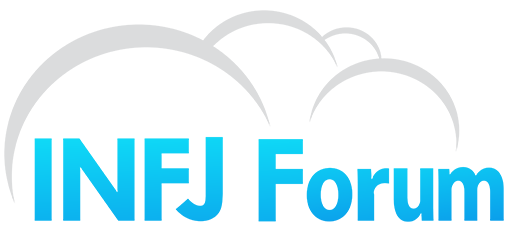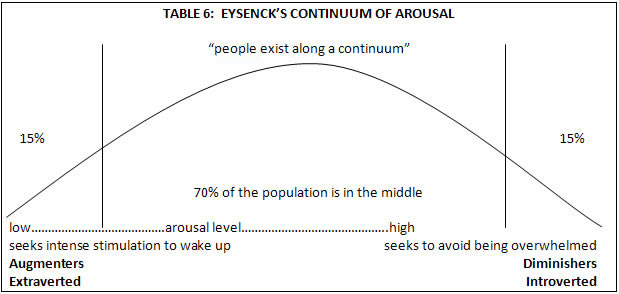I think I've unlocked the reason behind the phenomenon of Ambiverts, those of us who seem both introverted and extroverted - not simply well balanced.
Most people have an Enneagram type (motivations set) that is in alignment with their MBTI type (mental perspective). This is a natural occurance, which is why it is so common. As we develop as people, we will naturally create motivations that are based on our perceptions. Therefore, most INFJs are 9s because Ni and Fe will often either seek harmony and imagination. Those that had some influence make them feel different or defective because of their uniqueness early in life (a fairly common thing to happen in a world of perspectives that are not well suited to understand the INFJ child) often seek harmony and imagination while seeking to recover their identity in the form of becoming an Enneagram 4. This is why 9s and 4s are the most common Enneagram types for INFJs. A parent (or parents, or an admired authority figure such as a teacher) who expects excellence will often cause an INFJ child to develop a great deal of importance on perfectionism, and become Enneagram 1s as their Fe makes them want to please and their Ni makes them able to see how to excel. An INFJ child who was made to feel unsafe, insecure, or uncertain often enough will likely develop into an Enneagram 6 because Ni is so good at predicting, and develops a habit of it. Enneagram 1 and 6 are the next most common INFJ types. All four of these types align with INFJ's 'introverted' perspective.
It is only when people are subjected to some manner of unusual circumstances (often long term and frequent) that this process is disrupted and the natural way in which perspective reacts by developing base motivations is superceded. For example, a highly neglected INFJ child could develop into an Enneagram 2 if it becomes clear that their needs are only met when they are proactive in giving affection - or an Enneagram 3 if they were only given attention when they achieved. An INFJ child who suffered through enough child abuse could become an Enneagram 8 (or Counterphobic 6) as a reaction to not wanting to be a victim ever again. All of these motivation sets would cause an INFJ to focus on 'extroverted' mechanisms to get their needs met, despite their inherent introverted perspectives.
Therefore, it is possible for any MBTI type to develop an 'unnatural' motivation set. While these are rare, and obviously exceptions to the rule, they do happen. Often, these individuals lead 'troubled' lives because their minds are not well suited to achieving their deeper motivations' goals, causing them to often seem at odds with themselves.
However, these individuals explain the bulk of the 'Ambivert' population - those who seem like they are both introverted and extroverted, not just in the middle, and should not be confused with people who have well developed and therefore balanced functions, as these people are still fairly easy to spot their dominant functions because they've never had much need to use other functions to achieve their goals - and therefore develop function sets that solidly support one another, rather than compete with each other.
Most people have an Enneagram type (motivations set) that is in alignment with their MBTI type (mental perspective). This is a natural occurance, which is why it is so common. As we develop as people, we will naturally create motivations that are based on our perceptions. Therefore, most INFJs are 9s because Ni and Fe will often either seek harmony and imagination. Those that had some influence make them feel different or defective because of their uniqueness early in life (a fairly common thing to happen in a world of perspectives that are not well suited to understand the INFJ child) often seek harmony and imagination while seeking to recover their identity in the form of becoming an Enneagram 4. This is why 9s and 4s are the most common Enneagram types for INFJs. A parent (or parents, or an admired authority figure such as a teacher) who expects excellence will often cause an INFJ child to develop a great deal of importance on perfectionism, and become Enneagram 1s as their Fe makes them want to please and their Ni makes them able to see how to excel. An INFJ child who was made to feel unsafe, insecure, or uncertain often enough will likely develop into an Enneagram 6 because Ni is so good at predicting, and develops a habit of it. Enneagram 1 and 6 are the next most common INFJ types. All four of these types align with INFJ's 'introverted' perspective.
It is only when people are subjected to some manner of unusual circumstances (often long term and frequent) that this process is disrupted and the natural way in which perspective reacts by developing base motivations is superceded. For example, a highly neglected INFJ child could develop into an Enneagram 2 if it becomes clear that their needs are only met when they are proactive in giving affection - or an Enneagram 3 if they were only given attention when they achieved. An INFJ child who suffered through enough child abuse could become an Enneagram 8 (or Counterphobic 6) as a reaction to not wanting to be a victim ever again. All of these motivation sets would cause an INFJ to focus on 'extroverted' mechanisms to get their needs met, despite their inherent introverted perspectives.
Therefore, it is possible for any MBTI type to develop an 'unnatural' motivation set. While these are rare, and obviously exceptions to the rule, they do happen. Often, these individuals lead 'troubled' lives because their minds are not well suited to achieving their deeper motivations' goals, causing them to often seem at odds with themselves.
However, these individuals explain the bulk of the 'Ambivert' population - those who seem like they are both introverted and extroverted, not just in the middle, and should not be confused with people who have well developed and therefore balanced functions, as these people are still fairly easy to spot their dominant functions because they've never had much need to use other functions to achieve their goals - and therefore develop function sets that solidly support one another, rather than compete with each other.
Last edited:


